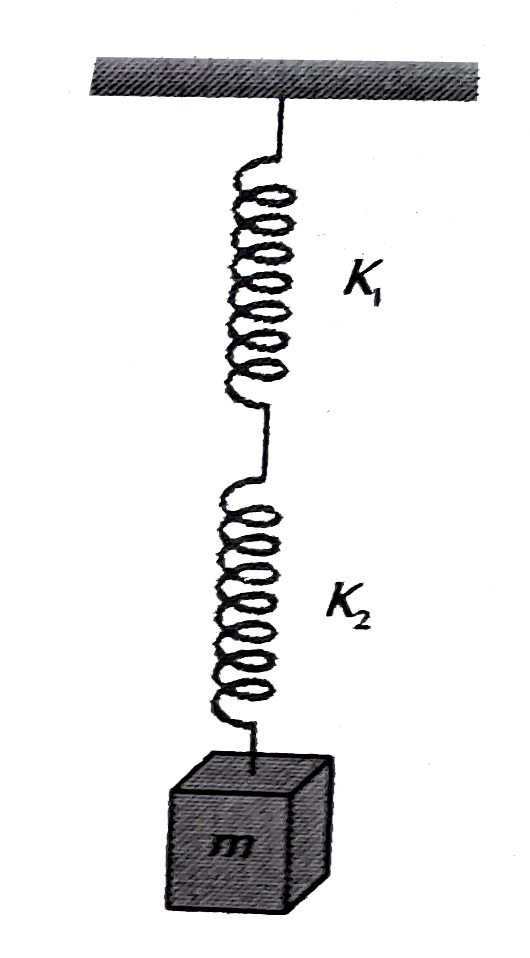Two particles x and y having same masses are suspended by two massless springs of spring constants k1=4 N/m and k2=9 N/m respectively. Find the ratio of amplitude of x and y if maximum velocites during oscillation are equal.
As ω=√km
ω∝√k
ω1ω2=√k1k2
a1ω1=a2ω2
ω1ω2=a2a1
From (i) and (ii)
∴a2a1=√k1k2
a2a1=√49
a2a1=23
⇒a1a2=32
Topper's Solved these Questions
- BOOK - MODERN PUBLICATIONCHAPTER - OSCILLATIONS EXERCISE - Competition File (Multiple choice questions)20videos
OSCILLATIONS
- BOOK - MODERN PUBLICATIONCHAPTER - OSCILLATIONS EXERCISE - Competition File (Multiple choice questions) AIPMT/NEET other State Boards for Medical Entrance14videos
OSCILLATIONS
- BOOK - MODERN PUBLICATIONCHAPTER - OSCILLATIONS EXERCISE - Revision Exercises (Long Answer Questions)5videos
OSCILLATIONS
- BOOK - MODERN PUBLICATIONCHAPTER - MOTION IN A STRAIGHT LINE EXERCISE - CHAPTER PRACTICE TEST16videos
MOTION IN A STRAIGHT LINE
- BOOK - MODERN PUBLICATIONCHAPTER - PHYSICAL WORLD EXERCISE - Revision exercises (Long answer questions)6videos
PHYSICAL WORLD
Similar Questions
Two particles A and B of equal masses are suspended from two massless springs of spring constants k1=4N/m and k2=8N/m respectively. If maximum velocities during oscillation are equal, fing the ration of amplitudes of A and B.
View SolutionTwo particles P1andP2 having identical masses are suspended from two massless springs of spring constant k1 = 5 N/m and k2 = 8 N/m respectively. If maximum velocity of oscillation for particle P1 is twice than for particle P2, then find the ratio of amplitudes for P1 and P2.
View Solution
Knowledge Check
- Question 1 - Select One
Two particles (A) and (B) of equal masses are suspended from two massless spring of spring of spring constant k1 and k2, respectively, the ratio of amplitude of (A) and (B) is.
A(a) √k1/k2B(b) k2k1C(c ) √k2/k1D(d) k_(1)/k_(2) - Question 2 - Select One
Two particle A and B of equal masses are suspended from two massless springs of spring constants k1 and k2, respectively. If the maximum velocities, during oscillations are equal, the ratio of amplitude of A and B is (4/3)×1000kg/m3. What relationship betwen t and t0 is ture?
A√k1/k2Bk1/k2C√k2/k1Dk2/k1 - Question 3 - Select One
Two particles A and B of equal masses are suspended from two massless springs of spring constants k1 and k2, respectively, If the maximum velocities, during oscillation, are equal, the ratio of amplitude of A and B is
A√k1k2Bk2k1C√k2k1Dk1k2
Two particles A and B of equal masses are suspended from two massless springs of spring constants K1andK2 respectively. If the maximum velocities during oscillations are equal. the ratio of the amplitude of A and B is
View SolutionTwo bodies M and N of equal masses are suspended from two separate massless springs of spring constants k1 and k2 respectively. If the two bodies oscillate vertically such that their maximum velocities are equal, the ratio of the amplitude of vibration of M to the of N is.
View SolutionTwo bodies P and Q of equal masses are suspended from two separate massless springs of force constants k1 and k2 respectively. If the two bodies oscillate vertically such that their maximum velocities are equal. The ratio of the amplitude of P to that of Q is
View SolutionTwo bodies A and B of equal mass are suspended from two separate massless springs of spring constant k1andk2 respectively. If the bodies oscillate vertically such that their maximum velocities are equal, the ratio of the amplitude of A to that of B is
View SolutionA mass M is suspended by two springs of force constants K1andK2 respectively as shown in the diagram. The total elongation (stretch) of the two springs is
 View Solution
View Solution

